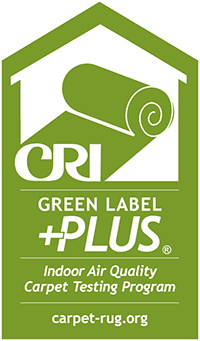The Dirty Details
Synthetic Chemicals
Most carpet is made from synthetic fibers, usually nylon and polypropylene. Both materials are made from non-renewable petroleum and emit harmful VOCs into the air.
Carpet backing is commonly made with a synthetic rubber derived from styrene and butadiene, both of which are respiratory irritants at low levels of exposure. Long-term exposure to high levels of styrene is associated with nerve damage, and long-term exposure to butadiene is associated with cancer and heart disease. A byproduct of the rubber, 4-PCH, is a VOC that causes the distinctive new carpet smell. 4-PCH has been associated with respiratory symptoms, eye irritation and rashes, and can also react with other chemicals to produce formaldehyde, a known human carcinogen.
Carpet backing may also be made from polyvinyl chloride, or PVC, which can contain eye and respiratory irritants, and endocrine-disrupting phthalates. PVC is produced using vinyl chloride, which is known to cause cancer and liver damage in PVC plant workers. When burned, PVC also produces highly toxic dioxins, which can cause cancer, and reproductive, developmental and immune disorders.
Carpet Adhesives
Like carpet fibers and backing, carpet glues and sealants can emit harmful VOCs, may contain toxic petroleum-based solvents, and may be made with the same synthetic rubber used in carpet backing.
Carpet Treatments
Carpets are often treated with stain-resistant, antimicrobial or moth-proofing chemicals, all of which may be harmful when inhaled or ingested.
Many synthetic carpets are treated with perfluorinated chemicals, or PFCs, to waterproof them and prevent stains. These chemicals, found in products like Stainmaster or Scotchgard, have been identified as likely carcinogens, and are associated with birth defects and hormone disruption.
Carpets are also sometimes treated with antimicrobial coatings, like Ultrafresh, to prevent bacterial growth in the fibers. Until 2013, Ultrafresh contained the chemical tributyltin, a persistent organic pollutant, which is an endocrine disruptor and is extremely toxic to aquatic life. Newer versions of Ultrafresh contain other harmful antimicrobial chemicals like triclosan, which is another hormone-disrupting chemical.
Carpet Padding
The most common type of carpet padding is made from scraps of recycled polyurethane foam that have been glued and bonded together to form a continuous sheet. Because the foam is recycled, it is likely to contain chemical flame retardants originally added for furniture or mattress applications. Older carpet cushion may contain PBDEs, a very hazardous flame retardant that has now been phased out of the U.S. market, but that lingers in carpet padding and older furniture.
Dust, Allergens and Pollutants
Even with regular vacuuming, carpets trap household dust, pet dander and mold spores, as well as dirt, lead and pesticides tracked in from outside. Pesticides that typically break down after a few days outdoors in the sun can last for years in indoor carpet. Carpets are also the perfect environment to harbor dust mites, mold and mildew, which are all common allergens.
The American Lung Association recommends vacuuming at least three times a week with a vacuum fitted with a HEPA filter to remove dirt and allergens, but even then, not all of the pollutants will be removed. And unfortunately, dust and other particles disturbed during vacuuming or other activity in the room will become redistributed in the air.
Removing dust and dirt from wood or tile floors is much easier, whether you vacuum or wet-mop.

